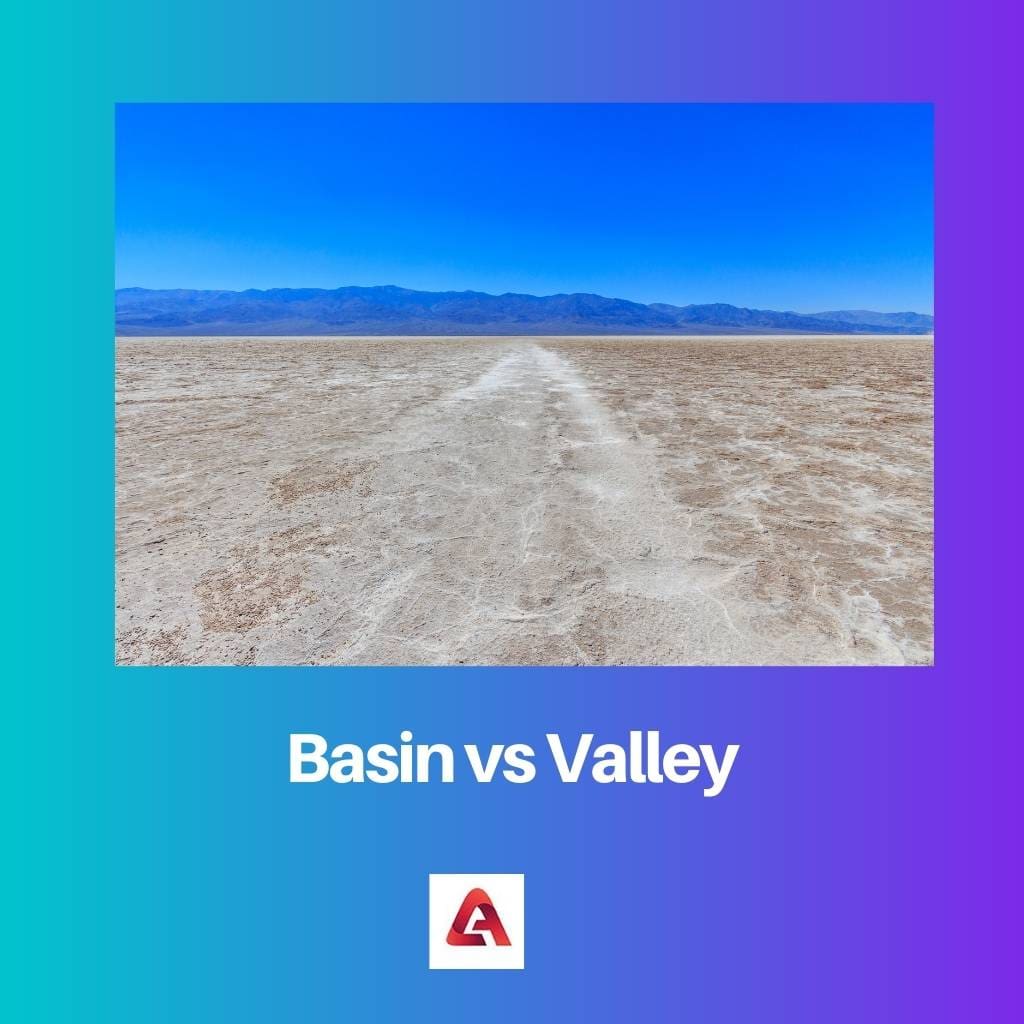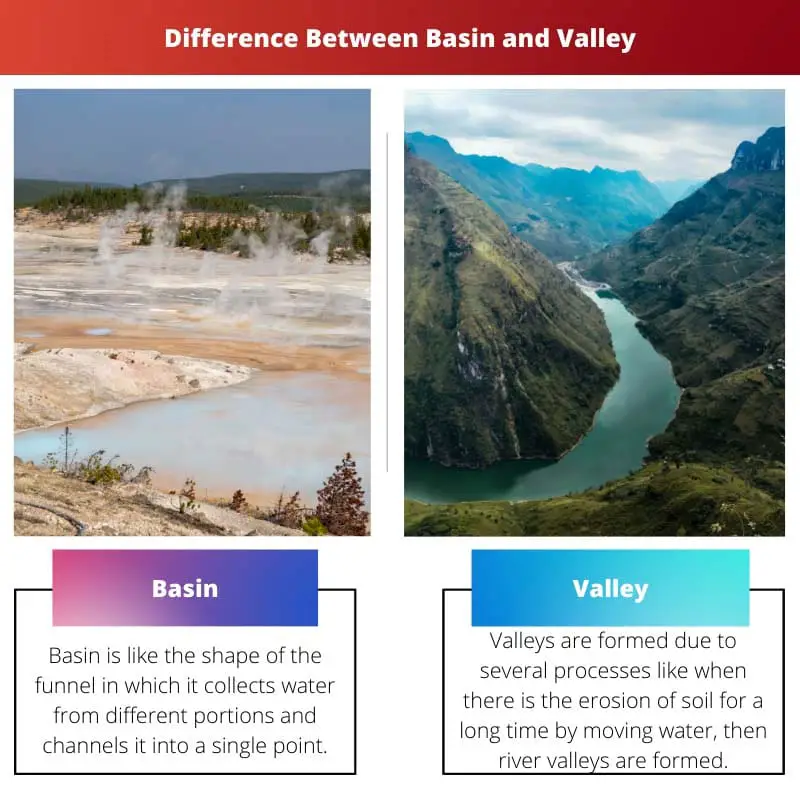Our earth’s surface is covered in 70% water, and the remaining 30% consists of land masses. Earth’s Surface is mostly made up of rocks. The layer is formed by a hard crust of lava which was formed on the surface of the earth some 4.5 billion years ago.
Because of the movement in tectonic plates, many formations are formed on the surface. Basins and Valleys are examples of this. Basin is formed on land, whereas valleys are formed between hills and mountains.
Key Takeaways
- A basin is a low-lying land surrounded by higher elevations, while a valley is a depression or hollow between two mountains or hills.
- A basin can be created by tectonic activity or erosion, while a valley is created by erosion.
- A basin is larger than a valley and may contain a lake or other body of water, while a valley is smaller and does not contain water.
Basin vs Valley
A valley is a depression on the Earth’s surface that is ‘V’ or ‘U’ shaped, surrounded by mountains and hills. A basin is also a depression on the Earth’s surface but is surrounded by elevated landforms other than mountains and hills and is circular. It is smaller than a valley.

Basin is referred to by many names like drainage basin, river basin, water basin, catchment basin etc. Basin is an area of land which collects precipitation and drains itself into the water sources like rivers, bays etc.
Basin can be connected to other basins in a lower elevation and have various subdivisions, which in turn will drain into the common outlet. In North America, the basin is commonly known as a watershed.
Valley is a low elevated area that runs between mountains and hills. Valleys are formed because there is an erosion of land for a longer time. Some valleys are also formed by glacial ice.
In deserted areas, Valleys are very dry, or they may contain a watercourse, but it happens rarely.
Then there is Rift Valley which is formed because of the earth’s movement. Valleys are referred to by many names according to their characteristics like Steelhead Valley, Dry Valley, Longitudinal Valley, etc.
Comparison Table
| Parameters of Comparison | Basin | Valley |
|---|---|---|
| Names | Watershed, Catchment area, Catchment basin, river basin, water basin, etc. | Steephead Valley, Dry Valley, Longitudinal Valley, River Valley, Glacial valley, etc. |
| Shape | It is like an oval or circular shape. | It has a U-shape and V-shape. |
| Size | They are wider and shorter. | They are narrow and long. |
| Largest | Amazon Basin | San Luis Valley of Colorado |
| Characteristics | Streams and Creeks are its characteristics. | Elongated Depression can be narrow and deep. |
What is Basin?
Basin is like the shape of a funnel in which it collects water from different portions and channels it into a single point. Basins are separated by another basin by a drainage divide, which creates a barrier in higher geographical areas like ridges, hills etc.
There are various ocean basins in the world. The largest drainage of water from land to ocean occurs in the Atlantic Ocean, i.e. 48%. Then there is the Arctic Ocean which accounts for 17%.
The Pacific Ocean and the Indian Ocean account for 13% drainage of water. Last is the Southern Ocean, in which Australia and Antarctica drain out.
There are five river basins in the world which are, the largest starting from Amazon, which is 7M km2, the Congo, which is 4M km2, the Nile, which is 3.4M km2, the Mississippi, which is 3.22M km2, and last is the Río de la Plata which is 3.17M km2.
Rivers that drain most of the water are Amazon, Ganga and Congo basins. Some basins do not drain themselves into oceans but seas, rivers, lakes etc.
There are 18%of land drains in the world which drain themselves into other sources besides oceans. Examples are the Caspian Sea, Aral Sea, Dead Sea etc.
Basins are very important for our ecological system as it carries nutrients and sediments from the ground, which also leads to the formation of delta and estuary.
Basins also carry pollutants containing nitrogen, phosphorus, artificial fertilizers, potassium etc. which disturbs the balance of nutrient deposits and results in eutrophication. Many factors tell us about flooding, like shape, size, soil type, topography, and land use.

What is Valley?
Valleys are formed due to several processes when there is the erosion of soil for a long time by moving water, and then river valleys are formed. When small valleys turn into large valley that reaches the ocean, it becomes an internal drainage basin ultimately.
In Glacier regions, valleys are formed because of the erosion of glaciers that are U-shaped. River valleys are V-shaped. Rift valleys are formed when there is a shift in tectonic plates.
The portion of the Valley which are flat between its sides is called as Valley floor. It is formed by river sediments. Depending on rock type, climate and topography, plain, U-shaped and V-shaped valleys can be formed.
Valleys can be hanging, trough-shaped, or box-shaped. It is believed that the first human civilization settled near valleys, and there are many evident proofs also, like in the Nile, Indus, Ganges, Yangtze, Yellow River, Tigris-Euphrates, Mississippi, and arguably Amazon.
Valleys are useful because they are connected to water, a fresh source, and good for irrigation and the agricultural process. In the valley, there is very little chance of flooding. Valley is a hollow or depression.
It is very larger than the basin but is narrow in size. They range from 1 to 10 kilometres in width. Most of the valleys have horizontal floors.
River valleys take many years, and the process of formation is slow. The largest valley in the world is the San Luis Valley of Colorado, an alpine valley 7500 feet above sea level.

Main Differences Between Basin and Valley
- Watershed, Catchment area, Catchment basin, river basin, drainage basin, water basin etc., are different names of Basin. Steephead Valley, Dry Valley, Longitudinal Valley, River Valley, Glacial valley, Alpine Valley etc., are its different types.
- Basin is like an oval, funnel or circular shape. Valleys have a U-shape, trough-shaped box shape and V-shape.
- Basin is wider than the valley and shorter in length. Valley is narrow and longer than the basin.
- The largest River basin in the world is Amazon Basin. The largest Valley in the world is the San Luis Valley of Colorado.
- The flow of Streams and Creeks determines the characteristics of the Basin. Elongated Depression, a formation that can be narrow and deep, is the characteristic of Valley.





